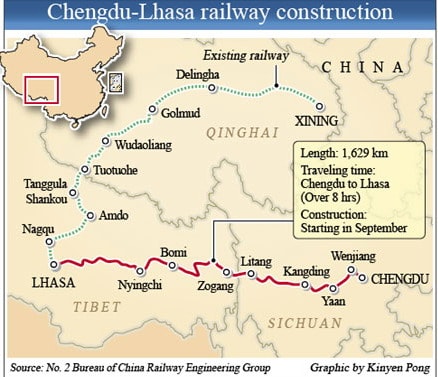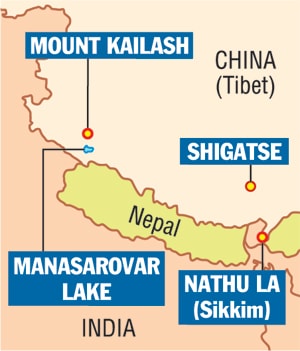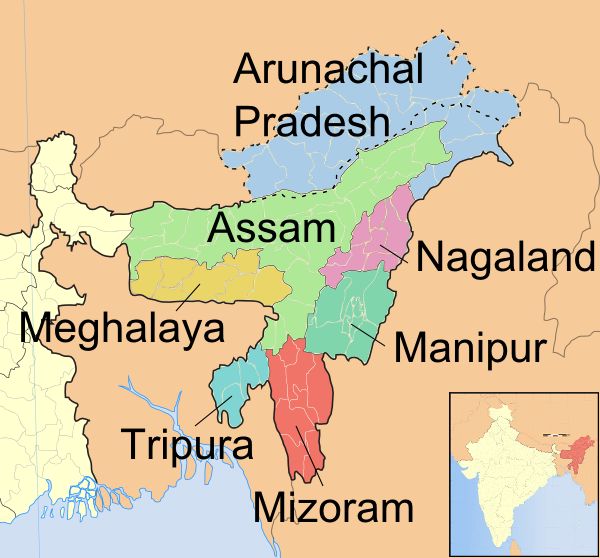IASbaba's Daily Current Affairs Analysis, IASbaba's Daily Current Affairs July 2015, International, National, UPSC
Archives
IASbaba’s Daily Current Affairs- 13th July, 2015
INTERNATIONAL
Integrating Tibet with the world
- The ambitious Sichuan-Tibet railway project will connect Lhasa with Chengdu,
 and include Tibet in China’s transportation corridor to Europe.
and include Tibet in China’s transportation corridor to Europe. - China is on course to integrate the Tibet Autonomous Republic (TAR) into the global mainstream, with India and Nepal among the spurs that will connect it with South Asia.
How the Chengdu would be the Game changer?
- The extension of the railway to Chengdu would be a game changer, for it would integrate Tibet with China’s transportation corridor to Europe.
- This step would also be path-breaking, for it would establish a link between Tibet with the proposed Bangladesh-China-India-Myanmar (BCIM) economic corridor.
What is TAR-India connectivity?
- The Chinese are proposing another rail link, which could revolutionise contact
 between TAR and India.
between TAR and India. - In case that happens, it would establish a Chinese railhead in the Chumbi valley, only 31 kilometres away from the Nathu La pass that connects Tibet with Sikkim.
- The Nathu La pass is the channel for border trade, but Chinese officials say that Sikkim could become an important destination for investments and tourism as well.
IAS BABA’s Views
- China stresses that its bold enterprise is part of its plan to elevate the economies of backward regions.
- The growing linkages between Chinese and Indian provinces are the new drivers of Sino-Indian ties.
- Indian officials say that Yunnan and West Bengal are emerging as BCIM’s twin growth engines.
Connecting the dots:
- Briefly explain the controversial hydro-electric projects, involving China, India and Bangladesh.
- Write a note on how TAR links with the Association of the South East Asian Nations (ASEAN)?
NATIONAL
Centre appoints arbitrator for Vodafone tax case
- The government has appointed international lawyer Rodrigo Oreamuno to arbitrate on its behalf in the Rs.20,000 crore tax case with the UK telecom major Vodafone.
- Costa Rica-based Oreamuno replaces former Chief Justice of India R C Lahoti who had in May recused himself.
What’s Vodafone tax case?
- The case concerns a tax dispute between the Vodafone group and the Indian
 income tax (IT) authorities over the acquisition by Vodafone International Holdings BV (VIH) (part of the Vodafone group and a company resident for tax purposes in the Netherlands) of the entire share capital of CGP Investments (Holdings) Ltd (a company incorporated in Hong Kong but resident for tax purposes in the Cayman Islands) on February 11, 2007 for about $11 billion (Rs 55,000 crore) from Hutchison Telecommunications International Ltd (HTIL).
income tax (IT) authorities over the acquisition by Vodafone International Holdings BV (VIH) (part of the Vodafone group and a company resident for tax purposes in the Netherlands) of the entire share capital of CGP Investments (Holdings) Ltd (a company incorporated in Hong Kong but resident for tax purposes in the Cayman Islands) on February 11, 2007 for about $11 billion (Rs 55,000 crore) from Hutchison Telecommunications International Ltd (HTIL).
What is the Verdict of Supreme court?
- The Supreme Court judgment makes it a point to emphasize that even a subsidiary has an identity that is distinct from its parent holding company.
- The second interesting aspect of the Supreme Court judgment is that it argues for a “look at” test in which tax authorities consider the entire Hutchison structure as it existed, “holistically”, at its face value, and not adopt a “dissecting approach”.
- In other words, authorities should not ask whether the transaction is a tax avoidance method, but apply the “look at” test to ascertain its legal nature
- The Supreme Court judgment in the Vodafone case argues that the ‘corporate veil’ cannot be pierced as long as there was no intention to avoid taxes.
IAS BABA’s View
- Framed in narrow legal terms and the limiting framework of the so-called welfare nation-states in the times of globalisation, it has become a continuously losing battle for the people at large.
- This tide can be turned only by a clear realisation that public good and modern corporations are inversely proportional to each other and this debate needs to be taken much beyond immediate tax and legal issues.
Connecting the dots:
- How and why corporations in India manage to undermine the law and the public good for the sake of private profit?
- Write a note on
- DTAA
- FDI
- FII
- IT Act of India
Inner line Permit
The campaign for the Inner Line Permit in Manipur is threatening to become a turmoil with fresh protests breaking out in Imphal.

What is Inner line Permit?
- Inner Line Permit (ILP) is an official travel document issued by the Government of India to allow inward travel of an Indian citizen into a protected/restricted area for a limited period.
- It is obligatory for Indian citizens from outside those states to obtain permit for entering into the protected state.
Which States require ILP?
- ILP’s valid for tourism purposes are granted as a matter of routine.
- The states which require the permit are Arunachal Pradesh, Nagaland, Mizoram, and some connecting roads of these states.
Why India needs ILP?
- The document is an effort by the government to regulate movement to certain areas located near the international border of India.
- Despite the fact that the ILP was originally created by the British to safeguard their commercial interests, it continues to be used in India, officially to protect tribal cultures in northeastern India.
Connecting the Dots:
- Write a note on Different Kinds of ILP.
- Why the people of Manipur are demanding the ILP?
- What are the Advantages and Implications of ILP to India?













